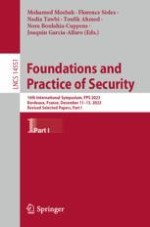2024 | OriginalPaper | Chapter
Does the Anchoring Effect Influence Individuals’ Anti-phishing Behavior Intentions?
Authors : Yukiko Sawaya, Ayane Sano, Takamasa Isohara, Akira Yamada, Ayako Komatsu
Published in: Foundations and Practice of Security
Publisher: Springer Nature Switzerland
Activate our intelligent search to find suitable subject content or patents.
Select sections of text to find matching patents with Artificial Intelligence. powered by
Select sections of text to find additional relevant content using AI-assisted search. powered by
